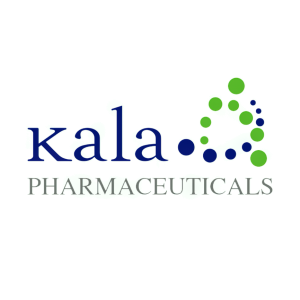KALA BIO Reports First Quarter 2025 Financial Results and Provides Corporate Update
Rhea-AI Summary
Positive
- Cash position of $42.2M sufficient to fund operations into Q1 2026
- Reduced net loss to $8.9M in Q1 2025 from $11.8M in Q1 2024
- Decreased operating expenses with G&A down to $4.6M from $5.4M
- KPI-012 targets PCED market of ~100,000 U.S. patients with no FDA-approved treatments
- Phase 2b trial could potentially serve as first of two pivotal studies for BLA submission
Negative
- Continued cash burn with decrease from $51.2M to $42.2M in Q1
- Still operating at a significant loss of $10.7M in Q1
- No revenue generation reported
- Dependence on successful clinical trial results for future growth
Insights
KALA BIO shows steady pipeline progress with KPI-012 while maintaining sufficient cash runway into Q1 2026 despite ongoing quarterly losses.
KALA BIO's Q1 2025 financial results demonstrate a balanced fiscal position with
Looking at operational metrics, both G&A (
The market opportunity KALA is targeting appears substantial, with an estimated 100,000 PCED patients in the U.S. alone and no FDA-approved treatments covering all PCED etiologies. The company's mesenchymal stem cell secretome (MSC-S) platform technology shows promise beyond PCED, with potential applications in Limbal Stem Cell Deficiency (another 100,000-patient market opportunity) and inherited retinal diseases through their preclinical KPI-014 program.
What's particularly promising is the potential for the ongoing CHASE trial to serve as the first of two pivotal studies required for BLA submission, which could accelerate KPI-012's path to market if data is positive. The expansion of clinical trial sites to Latin America suggests efforts to enhance enrollment and diversify the patient population, which could strengthen eventual regulatory submissions.
While KALA remains pre-revenue and dependent on its cash reserves, their technological approach addressing multiple mechanisms of impaired corneal healing could provide a competitive advantage in a market lacking effective treatments. The upcoming Q3 data readout represents a critical inflection point that will significantly impact the company's trajectory and potential partnership opportunities.
-- Ongoing patient enrollment in Phase 2b CHASE trial of KPI-012 in Persistent Corneal Epithelial Defect (PCED); topline data anticipated in 3Q 2025 --
-- Cash resources of
ARLINGTON, Mass., May 14, 2025 (GLOBE NEWSWIRE) -- KALA BIO, Inc. (NASDAQ:KALA), a clinical-stage biopharmaceutical company dedicated to the research, development and commercialization of innovative therapies for rare and severe diseases of the eye, today reported financial results for the first quarter ended March 31, 2025 and provided a corporate update.
“This year, our top priority is advancing the development of KPI-012 towards key milestones,” said Todd Bazemore, interim Chief Executive Officer of KALA BIO. "We are targeting to report topline results from the Phase 2b CHASE trial of KPI-012 in the third quarter of this year, which, if successful could serve as the first of two pivotal trials needed to support a BLA submission. KPI-012 has potential to be the first therapy that can address all underlying etiologies of PCED, through a multifactorial mechanism of action that addresses the multiple impaired corneal healing processes that can cause PCED. We look forward to delivering on our near-term data readout and unlocking the full potential of the MSC-S platform technology for the treatment of rare and severe ocular diseases.”
First Quarter and Recent Business Highlights:
KALA’s innovative pipeline is based on its proprietary mesenchymal stem cell secretome (MSC-S) platform. KALA believes the multifactorial mechanism of action of its MSC-S platform technology may enable it to generate product candidates for a range of rare, ocular diseases and is evaluating the potential development of this technology for multiple rare, front- and back-of-the-eye diseases.
KALA’s lead product candidate, KPI-012, contains growth factors, protease inhibitors, matrix proteins and neurotrophic factors to potentially correct the impaired corneal healing that is an underlying etiology of multiple severe ocular diseases.
KALA is initially developing KPI-012 for the treatment of Persistent Corneal Epithelial Defect (PCED), a persistent, non-healing corneal defect or wound that is refractory to conventional treatments which, if left untreated, can lead to significant complications, including infection, corneal perforation/scarring and vision loss. PCED has an estimated incidence of approximately 100,000 patients in the U.S., representing a potentially sizeable market opportunity as there are currently no U.S. Food and Drug Administration (FDA)-approved prescription products with a broad indication covering all underlying etiologies of PCED.
- KALA continues to enroll patients in the CHASE (Corneal Healing After SEcretome therapy) Phase 2b clinical trial evaluating KPI-012 for the treatment of PCED and is targeting topline data in the third quarter of 2025. The Company has also activated clinical trial sites in Latin America. Contingent on positive results and subject to discussion with regulatory authorities, the Company believes the CHASE Phase 2b trial could potentially serve as the first of two pivotal studies required to support the submission of a Biologics License Application (BLA) to the FDA.
- KALA is also exploring the potential of KPI-012 for additional rare, front-of-the-eye diseases, including Limbal Stem Cell Deficiency (LSCD). LSCD is characterized by the loss or deficiency of limbal epithelial stem cells, which can result in recurrent epithelial breakdown, conjunctivalization, inflammation, neovascularization and other sequalae that can lead to significant symptomology and a loss of corneal clarity and vision impairment. Like PCED, LSCD represents a potentially substantial market opportunity, with an estimated incidence of 100,000 patients in the U.S.
KPI-014, KALA’s preclinical program to evaluate the utility of its MSC-S platform for inherited retinal degenerative diseases, contains neurotrophic factors, growth factors, anti-inflammatory or immune-modulatory factors and antioxidant inhibitors with the potential to protect and preserve retinal cell function. Secretomes have demonstrated a neuroprotective effect in both in vitro and in vivo models of retinal degeneration. KALA believes KPI-014 could offer a gene-agnostic approach for the treatment of rare inherited retinal diseases, such as Retinitis Pigmentosa and Stargardt Disease.
Financial Results:
Cash Position: As of March 31, 2025, KALA had cash and cash equivalents of
First Quarter 2025 Financial Results:
- G&A Expenses: For the quarter ended March 31, 2025, general and administrative (G&A) expenses were
$4.6 million , compared to$5.4 million for the same period in 2024. The decrease was primarily due to a decrease in employee-related costs. - R&D Expenses: For the quarter ended March 31, 2025, research and development (R&D) expenses were
$6.1 million , compared to$6.4 million for the same period in 2024. The decrease was primarily related to a decrease in medical affairs-related KPI-012 development costs. - Loss on Fair Value Remeasurement of Contingent Consideration: For the quarter ended March 31, 2025, the loss on fair value remeasurement of contingent consideration, in connection with the Combangio acquisition, was less than
$0.1 million , compared to$0.2 million for the same period in 2024. - Operating Loss: For the quarter ended March 31, 2025, loss from operations was
$10.7 million , compared to$11.9 million for the same period in 2024. - Net Loss: For the quarter ended March 31, 2025, net loss was
$8.9 million , or$1.41 per share, compared to a net loss of$11.8 million , or$4.20 per share, for the same period in 2024. The weighted average number of shares used to calculate net loss per share was 6.3 million for the quarter ended March 31, 2025, and 2.8 million for the quarter ended March 31, 2024.
About KALA BIO, Inc.
KALA is a clinical-stage biopharmaceutical company dedicated to the research, development and commercialization of innovative therapies for rare and severe diseases of the eye. KALA’s biologics-based investigational therapies utilize KALA’s proprietary mesenchymal stem cell secretome (MSC-S) platform. KALA’s lead product candidate, KPI-012, is a human MSC-S, which contains numerous human-derived biofactors, such as growth factors, protease inhibitors, matrix proteins and neurotrophic factors that can potentially correct the impaired corneal healing that is an underlying etiology of multiple severe ocular diseases. KPI-012 is currently in clinical development for the treatment of persistent corneal epithelial defect (PCED), a rare disease of impaired corneal healing, for which it has received Orphan Drug and Fast Track designations from the U.S. Food and Drug Administration. KALA is also targeting the potential development of KPI-012 for the treatment of Limbal Stem Cell Deficiency and other rare corneal diseases that threaten vision and has initiated preclinical studies to evaluate the potential utility of its MSC-S platform for retinal degenerative diseases, such as Retinitis Pigmentosa and Stargardt Disease. For more information on KALA, please visit www.kalarx.com.
Forward Looking Statements:
This press release contains forward-looking statements within the meaning of the Private Securities Litigation Reform Act of 1995 that involve substantial risks and uncertainties. Any statements in this press release about KALA’s future expectations, plans and prospects, including but not limited to statements about KALA’s expectations with respect to potential advantages of KPI-012 and its MSC-S platform; the clinical utility of KPI-012 for PCED; anticipated timelines to report topline data for the CHASE Phase 2b clinical trial of KPI-012; KALA’s belief that the CHASE Phase 2b trial could serve as the first of two pivotal trials required to support the submission of a BLA to the FDA; KALA’s plans to pursue research and development of KPI-012 and its MSC-S platform for other indications; expectations about the potential benefits and future operation of the CIRM award; KALA’s ability to achieve the specified milestones and obtain the full funding under the CIRM award; the sufficiency of KALA’s existing cash resources for the period anticipated; and other statements containing the words “anticipate,” “believe,” “continue,” “could,” “estimate,” “expect,” “intend,” “likely,” “may,” “plan,” “potential,” “predict,” “project,” “should,” “target,” “will,” “would,” and similar expressions constitute forward-looking statements. Actual results may differ materially from those indicated by such forward-looking statements as a result of various important factors, including: KALA’s ability to comply with the requirements under the CIRM award; uncertainties inherent in the initiation and conduct of preclinical studies and clinical trials; uncertainties regarding availability and timing of data from clinical trials; whether results of early clinical trials or trials in different disease indications will be indicative of the results of ongoing or future trials; whether results of the Phase 1b clinical trial of KPI-012 will be indicative of results for any future clinical trials and studies of KPI-012, including the CHASE Phase 2b clinical trial; whether interim data from a clinical trial will be predictive of the results of the trial; uncertainties associated with regulatory review of clinical trials and applications for marketing approvals; KALA’s ability to retain and hire key personnel; KALA’s ability to comply with the covenants under its loan agreement, including the requirement that its common stock continue to be listed on The Nasdaq Stock Market; the sufficiency of cash resources and need for additional financing and other important factors, any of which could cause KALA’s actual results to differ from those contained in the forward-looking statements, discussed in the “Risk Factors” section of KALA’s Annual Report on Form 10-K, most recent Quarterly Report on Form 10-Q and other filings KALA makes with the Securities and Exchange Commission. These forward-looking statements represent KALA’s views as of the date of this press release and should not be relied upon as representing KALA’s views as of any date subsequent to the date hereof. KALA does not assume any obligation to update any forward-looking statements, whether as a result of new information, future events or otherwise, except as required by law.
Financial Tables:
| KALA BIO, Inc. Balance Sheet Data (in thousands) (unaudited) | |||||
| March 31, 2025 | December 31, 2024 | ||||
| Cash and cash equivalents | $ | 42,222 | $ | 51,181 | |
| Total assets | 48,252 | 55,483 | |||
| Working capital (1) | 22,742 | 35,841 | |||
| Current portion of long-term debt | 15,503 | 10,336 | |||
| Long-term debt, net of discounts | 15,121 | 20,102 | |||
| Other long-term liabilities | 4,448 | 6,093 | |||
| Total stockholders’ equity | 5,708 | 12,332 | |||
(1) The Company defines working capital as current assets less current liabilities. See the Company’s consolidated financial statements for further information regarding its current assets and current liabilities.
| KALA BIO, Inc. Consolidated Statement of Operations (In thousands, except share and per share data) (Unaudited) | ||||||||
| Three Months Ended March 31, | ||||||||
| 2025 | 2024 | |||||||
| Costs and expenses: | ||||||||
| General and administrative | $ | 4,593 | $ | 5,422 | ||||
| Research and development | 6,055 | 6,351 | ||||||
| Loss on fair value remeasurement of contingent consideration | 21 | 158 | ||||||
| Total costs and expenses | 10,669 | 11,931 | ||||||
| Loss from operations | (10,669 | ) | (11,931 | ) | ||||
| Other income (expense): | ||||||||
| Interest income | 463 | 504 | ||||||
| Interest expense | (1,091 | ) | (1,455 | ) | ||||
| Grant income | 2,350 | 1,075 | ||||||
| Total other income (expense) | 1,722 | 124 | ||||||
| Net loss | $ | (8,947 | ) | $ | (11,807 | ) | ||
| Net loss per share attributable to common stockholders—basic and diluted | $ | (1.41 | ) | $ | (4.20 | ) | ||
| Weighted average shares outstanding—basic and diluted | 6,345,869 | 2,813,210 | ||||||
Investor Contact:
Taylor Steiner
taylor.steiner@precisionaq.com
212-362-1200







